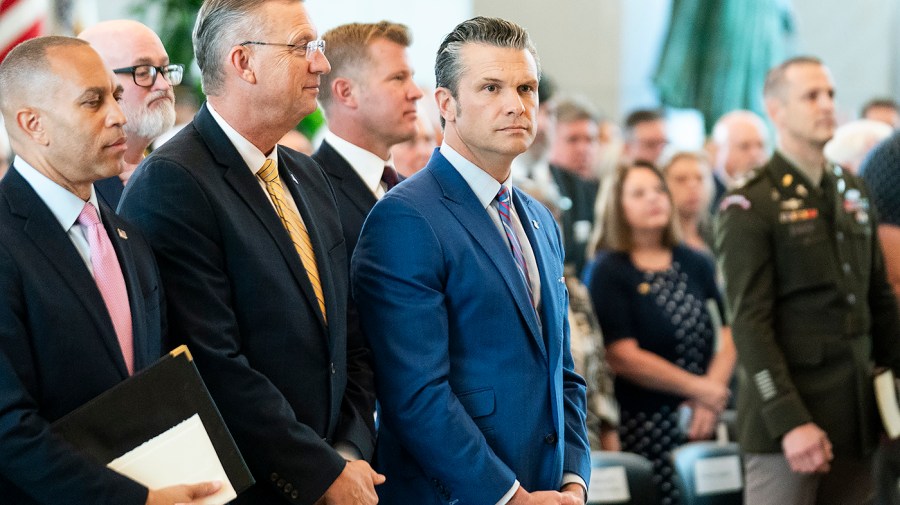Defense Secretary Pete Hegseth will meet with top military leaders next week, the Pentagon confirmed Thursday, following a report that the rare gathering will include hundreds of generals and admirals.
“The Secretary of War will be addressing his senior military leaders early next week,” chief Pentagon spokesperson Sean Parnell said in a statement to The Hill, offering no additional details.
The Washington Post first reported that Hegseth earlier this week ordered hundreds of the U.S. military’s generals and admirals to gather on short notice and without a stated reason. The meeting is expected to take place on Tuesday at a Marine Corps base in Quantico, Va., according to the Post.
More than a dozen people familiar with the matter told the outlet that the directive was sent to virtually all of the military’s top commanders worldwide — all senior officers with the rank of brigadier general or above, their Navy equivalent and their top enlisted advisers — more than 800 generals or admirals. It’s not clear how many had been ordered to attend the gathering in person.
The unexpected confab has created confusion and alarm, as there has not been a Defense secretary in recent history who has ordered such a large number of the military’s top officers to gather like this, and it comes at a time when the Trump administration has taken an axe to the senior ranks.
Meetings of top military officials are not unusual; four-star combatant commanders and the heads of the armed services typically meet at least twice a year in Washington, D.C., a confab that often includes a working dinner with the sitting president. In 2020 and 2021, with restrictions on in-person meetings due to the COVID-19 pandemic, military leaders relied on secure communications to meet remotely.
It is very rare, however, for such a large meeting of top officers in person in one location. The fast timing is also unusual. Such a gathering with senior leadership would typically take months to plan and prior notice would have to be given well in advance, as officers could be coming from the Middle East, Africa and Europe.
President Trump on Thursday downplayed the sudden meeting but claimed not to know what it would entail.
“Why is that such a big deal?” Trump said from the Oval Office. “You act like this is a bad thing, isn’t it nice that people are coming from all over the world to meet?”
Vice President Vance also dismissed questions about the gathering’s purpose.
“It’s actually not unusual at all and I think it’s odd that you guys have made it into such a big story,” Vance said.
But Greg Williams, the director of the Center for Defense Information at Project on Government Oversight, called the meeting “unprecedented” in its scale.
“It begs the question of why [Hegseth] would do something on such short notice and require so many people to show up in person,” Williams told The Hill. “The absence of public justification for something so unprecedented is in and of itself, a sort of concern.”
He added that the military normally doesn’t require such large, in-person meetings for a whole host of different reasons, including the disruption of ongoing operations, security and “just the sheer safety concerns of having that large a fraction of our military leadership all in one place,” calling it “really concerning.”
The upcoming meeting comes after the Trump administration has fired numerous senior leaders this year, and it follows Hegseth’s directive to reduce the number of general officers by 20 percent as the administration eyes changes to where troops are placed across the globe.
Hegseth in May ordered the number of active-duty four-star generals and admirals in the U.S. military and general officers in the National Guard to be cut by at least 20 percent. He also wants the total number of general and flag officers — those with the rank of one star or higher — across the military to be slashed by 10 percent.
There are currently 838 total general officers and admirals on active duty, according to the Pentagon’s latest statistics from June. Hegseth’s May directive would cut that number to closer to 700.
Hegseth has described the effort as a “Less Generals More GIs Policy,” and was meant to “drive innovation and operational excellence, unencumbered by unnecessary bureaucratic layers that hinder their growth and effectiveness,” according to a video accompanying the memo.
Since February, the Trump administration has purged multiple senior military leaders, including former Joint Chiefs of Staff Chair Gen. CQ Brown, Chief of Naval Operations Adm. Lisa Franchetti, Coast Guard Commandant Adm. Linda Fagan, Air Force Vice Chief of Staff Gen. James Slife.
In addition, last month Hegseth fired Defense Intelligence Agency Director Lt. Gen. Jeffrey Kruse, Navy Reserve Chief Vice Adm. Nancy Lacore, and Naval Special Warfare Command head Rear Adm. Milton Sands.
Air Force Chief of Staff Gen. David Allvin, meanwhile, last month announced he would retire in November after he was asked to step down.
Other big changes at the Pentagon include a new national defense strategy that is reportedly expected to make homeland defense the top U.S. security concern, replacing China.
Updated on Sept. 26 at 10:17 a.m. EDT
